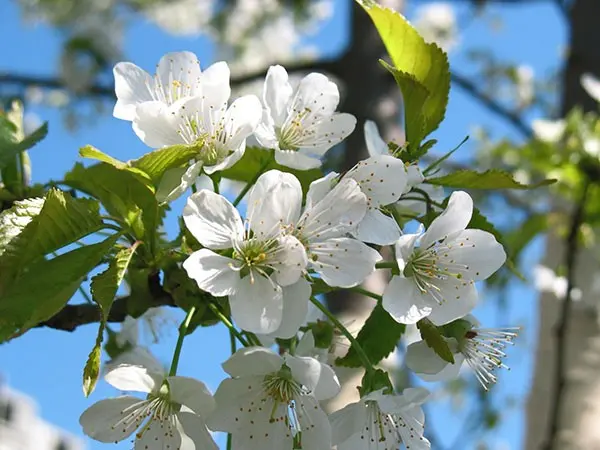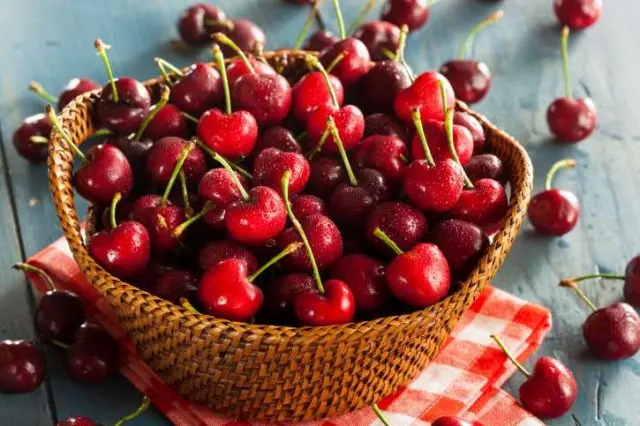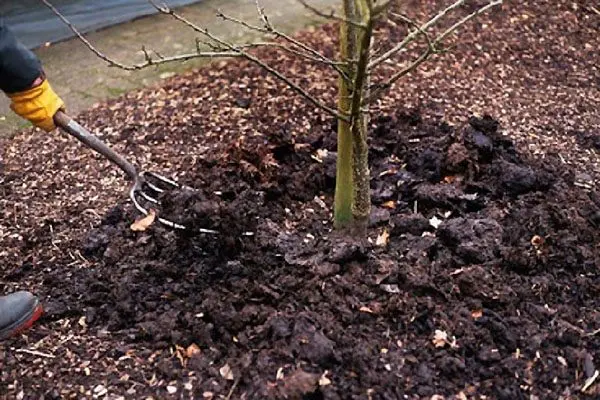Contents
Cherry Fatezh has become a real discovery for gardeners in the Central region. Initially, sweet cherry is considered a culture of the southern regions. She loves high temperatures and does not tolerate frost. However, science does not stand still. Breeders carry out activities for zoning and crossing varieties of sweet cherries in order to develop new, more resistant hybrids.
History of breeding
Cherry Fatezh is an achievement of domestic selection. The scientists Yevstratov A. I. and Enikeev H. K. worked on the creation of the variety at the All- Institute of Selection and Technology of Horticulture and Nursery. At the heart of their work, breeders used biostimulants and gamma rays.
In 1999, after a series of successful experiments with the Leningradskaya Zheltaya variety, a new hybrid was bred. It got its name in honor of the city of Fatezh, Kursk region. Within 2 years, tests were carried out on the zoning of the variety. As a result, the Fatezh sweet cherry was included in the State Register in 2001 and recommended for cultivation in the Central and North-West regions.

Description of Fatezh cherry
The Fatezh cherry variety is perfect for growing in the Moscow region and in general for the Central region. In the North-West, it is also quite possible to get a bountiful harvest, since the variety is zoned for a changeable climate and has increased frost resistance. In other climatic zones of the Federation, it is not realistic to grow Fatezh cherries because of the harsh long winters.
Cherry trees are quite tall, at least 3 m, the tallest specimens reach 5 m in height. The crown is dense and spreading, has a rounded shape due to the fact that adult branches deviate to the ground. The bark is brown in color and smooth in texture. Cherry leaves are located on the shoots quite densely. The leaf plates are long and wide, with a serrated border, not rigid, glossy and bright on top, and lighter and textured on the reverse side due to veins.
Features
The secret of the Fatezh sweet cherry is that it contains the main indicators characteristic of northern cultures. It is worth noting that there are some nuances, without which it will be quite difficult to get a good cherry harvest.
Drought resistance, winter resistance
Fatezh cherry winter hardiness is above average. The tree itself tolerates frosts down to -27 ˚C with a drop to -35 ˚C, and the buds often suffer from late frosts. With proper care, the Fatezh sweet cherry is restored in a few years and continues to bear fruit at the same level.
Cherry Fatezh calmly tolerates dry summers, as it loves light, well-drained soils. But this variety does not tolerate stagnant moisture.
Pollination, flowering period and ripening period
The first flowering of the Fatezh cherry begins 4 years after planting and occurs simultaneously with the blooming of foliage. Boiling white flowers are formed on the 5 lower buds of young shoots or on bouquet branches. Full ripening of cherries falls on the last decade of June – the first decade of July.

yield, fruiting
The fruiting of the Fatezh sweet cherry begins after 4 years, and the peak of the form is reached after 10 years. By this time, an average of 30 kg of berries can be harvested from each tree. The maximum figure for the Fatezh variety is 50 kg from 1 tree. The berries are yellow-red, round and slightly flattened. The weight of 1 fruit ranges from 4 to 6 g. The pulp of the sweet cherry is juicy, the peel is dense and smooth, so the crop tolerates transportation and storage well.
Scope of berries
Fatezh cherries have a dessert taste. The main note is sweet, with a slight sour aftertaste. Taste qualities are rated as very high. In addition, the fruits are not deformed during heat treatment. In this regard, Fatezh berries are suitable for fresh consumption, for canning, and for confectionery production.

Disease and pest resistance
Cherry Fatezh has a high immunity against fungal infections, so it is not afraid of the most common diseases, such as moniliosis and coccomycosis. Among insects, only the cherry fly, aphids and moths are of great danger. Fatezh cherries have a tendency to only one disease – gum disease, which can be easily avoided if the rules of cultivation are observed.
Advantages and disadvantages
| Pros | Cons |
| The tree easily tolerates frosty winters | Inability to self-pollinate |
| The height of the trees and the arrangement of the branches contribute to a comfortable harvest. | Vulnerability to gum disease |
| High keeping quality and safety of berries | Narrow distribution area |
| Excellent taste qualities | |
| High resistance to fungal infections |
Features of landing
Planting Fatezh cherries is not much different from other varieties. Features of the planting process are more likely to be related to climatic conditions, since this variety is zoned for a region in which the cultivation of sweet cherries is uncharacteristic in principle.
Recommended dates
In the Central and North-West region, it is best to plan the planting of Fatezh sweet cherries in the spring, as young and weak seedlings may not endure winter frosts after autumn planting.
In southern regions with mild winters, you can plant cherries in October, 15-20 days before the planned onset of frost. During this time, the cherry will have time to take root in a new place. The condition of the root system also affects the planting time. A seedling with open roots can take root only when planted in the spring, plants in a container (with a closed root system) successfully take root in both spring and autumn.
The optimal time for planting Fatezh cherries in spring is April, if spring comes late, then planting can be postponed to early May.
Choosing the right place
The choice of landing site should be taken seriously. Cherry Fatezh is demanding both in terms of soil quality and location in the territory. Heavy clay soils with a close occurrence of groundwater, open areas with strong winds and drafts, northern slopes and shaded areas, as well as lowlands are categorically unsuitable.

Areas fenced from the wind are well suited for planting cherries: old gardens, southern forest edges and slopes. It is allowed to plant Fatezh cherries along the walls of the house, but you need to retreat at least 3 m in order to avoid problems with the foundation in the future.
It is also worth considering that sweet cherries need a well-lit area and light-drained loamy soil. The acidity of the soil should be neutral within 6-7 pH. The occurrence of groundwater at least 2 m deep. Otherwise, you need to either form a high bed, or artificially create a high-quality drainage layer.
What crops can and cannot be planted next to cherries
Proper neighborhood helps plants develop more actively and protects against diseases and pests. Since the Fatezh sweet cherry does not self-pollinate, it is recommended to sow honey plants nearby. They actively attract bees and prevent the growth of weeds. Recommended honey plants:
- clover;
- mustard;
- phacelia.
Any trees and shrubs with stone fruits are suitable for the active growth of Fatezh cherries:
- cherry;
- apricot;
- plum;
- grapes.
The following crops are not suitable for co-cultivation:
- Solanaceae (tomatoes, potatoes, peppers) – spread disease.
- Gooseberries, raspberries, currants – take away nutrients.
- Sea buckthorn – blocks the development of the root system.
Selection and preparation of planting material
A quality seedling can only be purchased from a trusted nursery. The optimal height of the seedling is no more than 1 m, the root system is no more than 0,25 m. Cherries should have 5 healthy branches about 2 cm thick.
Before buying, you need to carefully inspect all parts of the plant. There should be no creases or other damage to the branches and roots. Black roots indicate the presence of the disease. Leaves need to be inspected from all sides, as pests and diseases are often found on the underside of the leaf plate.
Landing algorithm
Landing holes must be prepared in the fall, regardless of the timing of planting. The pit should be 0,7 m x 0,7 m x 0,7 m in size. In case of mass planting, the distance between the holes is 3 m.
The bottom of the hole is laid with a layer of drainage up to 7 cm thick. Expanded clay or broken bricks are suitable as drainage. The next layer is laid out a nutrient mixture of 1 kg of ash, 0,1 kg of sodium sulfate, 0,4 kg of superphosphate. Next comes a layer of earth 10 cm thick.
A seedling is installed on this layer, the roots are neatly straightened. Next to the seedling, you need to stick a peg and tie up the plant. The planting pit is covered with earth so that the root neck of the cherry is 5-8 cm deep. The earth is tamped and 30 liters of water are poured abundantly. A mulching layer of peat or humus 3-5 cm thick is laid on top.
Culture aftercare
In the future, the standard Fatezh cherry care procedure is carried out, which includes:
- Watering 1-2 times a month, 20 liters of water under a bush.
- Weeding and loosening the trunk circle.
- Pruning: spring (forming) and autumn (sanitary).
- Top dressing in spring (mineral complex) and autumn (organic).
- Shelter for the winter.

Diseases and pests, methods of control and prevention
| Diseases and pests | Signs of defeat | Prevention | Treatment |
| aphid | Twisting of young foliage and a large number of small bugs | Compliance with nitrogen application dosages | Spraying with garlic solution, ash, soapy water. If folk methods do not help, you can treat it with chemicals such as Fitoverm, Karbofos, Aktarin. Chemical treatment is acceptable before flower formation or after harvest. |
| cherry fly | Worms in berries | Autumn cleaning of the near-trunk area from leaves and weeds, digging the soil | |
| Pheidenitsa | Leaves eaten by caterpillars | ||
| Kokkomikoz | The leaves are covered with dots, quickly turn yellow and crumble. | Trees should not be planted next to cherries and cherries that are not resistant to fungal infections. You can not immediately plant cherries in the place of a shrub that has just been removed due to disease | Destruction of diseased plant parts. Spraying chemicals (e.g. Horus) |
| Moniliasis | The berries rot on the tree, the leaves dry up |
Conclusion
Cherry Fatezh is the best choice for the Central and North-West region. For more than 15 years, this variety has occupied a leading position due to the combination of such important qualities as frost resistance and resistance to diseases and pests, high yields and excellent fruit taste. Proper care will help to avoid possible problems, and the sweet cherry will actively bear fruit for about 10 years.









